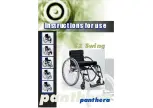
Instructions for use S2 Swing
Instructions for use S2 Swing
7
8
Figure 6.
Balancing.
7
6
8
Figure 8.
High brakes
.
Bild 7.
Single hand brake.
Figure 9.
Anti-tips.
6) Balancing the wheelchair
The balance of the wheelchair can be adjusted by moving the rear wheels back or
forwards depending on how much ‘rear balance’ you require. The chair will be
lighter at the front with more weight over the rear wheels. This makes the chair
easier to manoeuvre and it will also be easier to tip up onto the rear wheels, for
instance, when negotiating curbs, thresholds and so on. The chair should not be
balanced too far to the rear because this will increase the risk of tipping backwards.
It is important that you take time trying out a balance that suits your body and
driving techniques so that you adapt the chair to be as easy to drive as possible,
without increasing the risk of tipping backwards too much. You should always
have someone standing behind you when you try out the chair after adjusting the
balance. If you still feel unsure about the balance of your chair having tested it
thoroughly you should use anti-tips (accessory). The anti-tips eliminate the danger
of tipping backwards and they are easily removed when you no longer need them.
How to move the rear wheels:
Remove the rear wheels.
Loosen the nut casings (6) with the 22 mm cap key, and the nut to the wheel
attachment (7) using the 15 mm cap key on both sides of the chair.
You will now be able to push the wheel attachment (8) forward or back along
the horizontal frame tubing. It is important that you have the wheel attachment
in the same forward position on both sides of the chair. You can check this by
measuring the distance between the forward section of the vertical tubing and
the rear section of the wheel attachment as shown in fi gure 6 using a tape
measure or ruler, and check that the distance is the same on both sides.
Tighten the wheel attachments. When you tighten the wheel attachments you
should always fi rst tighten the nuts (6) on both sides, and then tighten the M10
nuts (7) on both sides. This sequence is important to ensure that the wheel
attachments are positioned correctly.
1.
2.
3.
4.
7) Single hand brake (accessory)
This brake is assembled under the seat tubing and can be adjusted in the same way
as the high brake. It is important to check that the brakes are placed at the same
distance on both sides of the frame as shown in fi gure 7.
N.B! As the air pressure falls, the tyre
becomes worn, or if you change the type
of tyre the effect of the brakes will vary.
You should therefore check the position
of the brakes in these circumstances.
High brakes
The brake should be adjusted to go 3-4 mm into the tyre
when in locked position. If a slight adjustment is required
this can be done by rotating the locking arm adjustment,
see fi gure 8, so that the brake goes further in/out on the
tyre depending on the direction in which you rotate. If a
major adjustment is needed, loosen the bolt on the inside
of the brake using the 5mm socket key. The brake can then
be pushed forward or back into the desired position and the
clamp then tightened again.
NB! The bolt on the inside of the clamp (under the seat)
should be opened to move the clamp, not the bolt on the
outside of the clamp.
Anti-tips (accessory)
When the anti-tips are folded out you can adjust the distance from the ground
by fi xing the wheel tubing in any of the four positions as shown in fi gure 9.
The anti-tips can be folded away under the
frame by pushing them down and twisting
them in under the seat. When you wish to
fold them out again, make sure that they
reengage into the lock tracks.
When learning how to drive on the rear
wheels you should have the anti-tips
positioned to be able to tip the chair up into
rear wheel balance.









